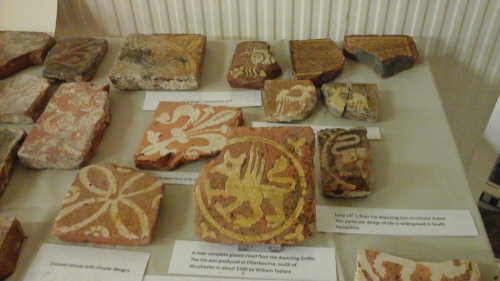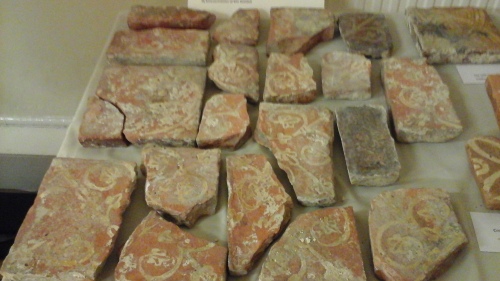
Fourteenth century tiles
You might not have given much thought to medieval floors, but they were quite varied and these days they offer good opportunities to a novelist for scene-setting or showing a character’s state of mind.
In Beloved Besieged Elaine covers the floor of her father’s hall with rushes strewn with sweet-smelling herbs and flowers for her betrothal celebration. In my current work in progress, the heroine drops to the floor of the main room of the inn in which she’s staying, even though she suspects it will result in an unpleasant stain on her clothes.
Not all medieval floors were equal. In most houses, the floors of the rooms on the ground floor were simply beaten earth. This always sounded unpleasant, especially when I saw the state of the floors in castles that I visited. Thanks to them I had visions of lumpy, uneven floors being swept away when they were brushed, or of bits of a floor sticking to shoes if someone entered the house from the rain, or of it being scratched up by dogs or cats. Then I saw one in the Medieval Merchant’s House in Southampton. That floor is very solid and secure and would last for a long time with only a little maintenance.

Earthen floor in the Medieval Merchant’s House, Southampton
It took a fair amount of effort to make such a floor and sometimes the neighbours were called on for help. As many people as the householder could get would walk on the floor for an afternoon (or longer) until it was flat and smooth. They literally walked round in circles until it was done. They would have a chat or a sing as they walked. This seems to me to be a very satisfactory way of providing a floor surface and is probably quicker and more enjoyable than laying a laminate floor.
The earthen floor would be covered with rushes. Rushes provided good insulation and could help to keep the floor clean. I know that I often point to The Secrets of the Castle for examples, but the archaeologists demonstrate the practicalities of medieval life so well. When she moved into a labourer’s hovel near the building site, Ruth Goodman pondered how the rushes might have been laid, since loose rushes would not stay where they were put for long. She concluded that they would probably have been tied together in bunches and then laid on the floor. Other historians and archaeologists have considered whether the rushes might have been woven into mats before being placed on the floor, but everyone seems to be agreed that loose rushes were not strewn on the floor. Rushes weren’t just used in houses. Almost every domestic beaten earth floor would have been covered in them.
In a public building, an inn, for example, the rushes would have contained dreadful things trodden in from outside by people and dogs, but in a hovel, where the rushes would have doubled up as the bedding for the occupants, they would have been kept much cleaner. In the spring and summer herbs and flowers could be added to make the rushes (and the room) smell sweeter and to disguise less welcome odours.

Fourteenth Century Tiles
Tiles provided a far more upmarket floor surface. Like everything else in medieval times, their production was very labour intensive. They required someone to dig the clay, which had to be cleaned and homogenised until it could be worked. Then it would be pressed into square, wooden moulds. After the tiles had been pushed out of the moulds, they would be dried and stacked in a kiln to be fired. A medieval kiln was more like an earthwork than an oven and firing could take twenty-four hours or more. Disaster was always close at hand. Bad weather could mean that the firing was delayed, or the tiles could be too wet and would explode when the water became hot enough to turn into steam.
Tiles could be plain or patterned with different coloured clay. Decorated tiles were for the very rich or churches. The photographs in this post are of encaustic tiles recovered from the site of Hyde Abbey in Winchester. The patterns are made by using different colours of clay. Like the ones in the photographs, they were usually of two colours, but they could contain up to six different colours. Because the pattern is not just on the surface, it remains as the tile is worn down.



That’s fascinating…I had never thought much of medieval floors beyond rushes through all the books I’ve read…I love the idea of all the neighbours walking around and round and singing!..and the tiles are beautiful.
LikeLiked by 1 person
They are lovely tiles.
LikeLiked by 1 person
Very interesting! I hadn’t thought much about the floors, but this is amazing! Thanks for sharing! And thanks for the help with my blog. For some reason, it wouldn’t work for me when I tried to pull it up in google. Hmmm….I’ve got my guru working on it though. 🙂
LikeLiked by 1 person
Thank you.
You’re very fortunate to have a guru. I hope it’s a simple problem to solve.
LikeLiked by 1 person
Me, too, April! Thanks again for your help! 🙂
LikeLiked by 1 person
I enjoyed reading about how many feet had to walk around to flatten the floors! I was just trying to describe the process of making roads to my son, and how the heavy machines tamp down dirt and STILL there are cracks as the earth moves. Seeing flooring that lasts (though not intended for half-ton pick-ups) is a reminder of the craftsmanship it takes to endure.
LikeLiked by 1 person
Thank you. One of those machines could probably do it in five minutes and it wouldn’t be as much fun.
LikeLiked by 1 person
So true!
LikeLiked by 1 person
I started wondering if you’d read Ruth Goodman’s experiments with rushes, and I’m glad you have. Well, of course you would have–why did I waste my time wondering?
LikeLiked by 1 person
I haven’t read anything by her about rushes. I’ve only got one of her books and it doesn’t mention them. Where does she write about them? I’ve only got what she said about them in the Secrets of the Castle TV series. As far as I know, there’s not a book based on that series. I’d buy it like a shot if there were.
LikeLike
I wasn’t sure I’d be able to find it, but the book is How to Be a Tudor: A Dawn-to-Dusk Guide to Everyday Life. You’ll love it.
LikeLiked by 1 person
Thank you. I’m sure I will. I’ll put it on the wish list.
LikeLiked by 1 person
Do you have me email address? I’m not likely to reread the book and would be happy to mail it to you if you’ll send me your address.
LikeLiked by 1 person
Thank you. That’s very kind of you. I’ll send you an email shortly.
LikeLike
I just spotted the typo on my comment.
Sigh.
LikeLiked by 1 person
I just thought it proof that you had integrated very well linguistically 🙂
LikeLiked by 1 person
I’m living in the wrong region, aren’t I? Isn’t that a northern thing?
LikeLike
It’s mainly northern. Some southerners will say something that’s written as “m'”, but that’s laziness on our part.
LikeLike
My in-laws lived in a orinally medieval farmhouse and the back door led into a room with a beaten earth floor – it was as hard as concrete and never became muddy, in fact it took some time before I even realised its true nature!
LikeLiked by 2 people
They’re good, aren’t they?
LikeLike
I recently saw some wonderful encaustic tiles displayed in St Denys Church. They came from St Denys Priory. It’s well worth a visit if you get the chance.
LikeLiked by 1 person
I saw the photograph and immediately thought that I wanted to go and have a look.
LikeLike
Treading beaten earth floors! I hadn’t heard of that before. The name always made me picture a line of people crawling back and forth across a floor and pounding it with wooden mallets. I suppose that would work, but it wouldn’t be nearly as much fun. I must try to see the floor in the Merchant’s House.
LikeLiked by 1 person
I’m hoping the Merchant’s House is open this year. It was closed last year, presumably for some work to be done, although the website didn’t say.
LikeLiked by 1 person
Ooh, that’s a worry.
LikeLike
You could always call, or email, English Heritage who own and run it.
LikeLiked by 1 person
I will. I was all geared up to go and see it from Chichester, but even so it may not be open anyway.
LikeLiked by 1 person
Great stuff – I really enjoyed that.
LikeLiked by 1 person
Thank you
LikeLike
Pingback: The Medieval Floor — A Writer’s Perspective – MobsterTiger
There is indeed something to be said about, in comparison, tiled floors today are rather boring except in the mediteranean area where they are encountered more.
LikeLiked by 1 person
Sven, thank you for your comment. Yes, we seem to have lost the desire for beautifully tiled floors in the north of Europe.
LikeLiked by 1 person
Pingback: Medieval Merchant’s House – The Hall | A Writer's Perspective
Pingback: Medieval Tiles – A Review | A Writer's Perspective
Yes, I think they prefere carpet 🙂
LikeLiked by 1 person
Pingback: Five Minutes With… @AprilMunday from A Writer’s Perspective #Blogging #FiveMinutesWith – Motivate Me
Pingback: The British Museum in Thirteen Objects – Relief Tile from St Albans Abbey | A Writer's Perspective
Pingback: A Visit to City Museum, Winchester | A Writer's Perspective